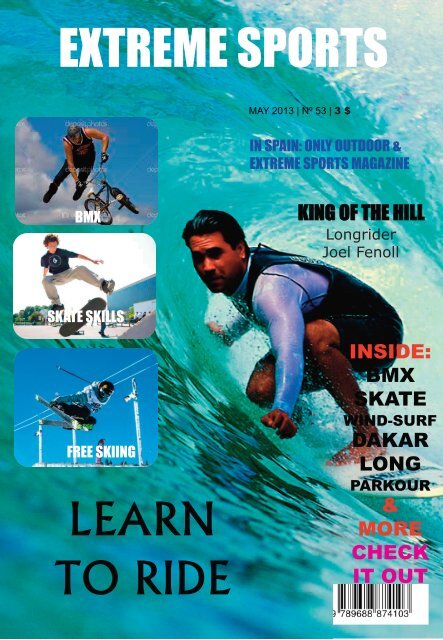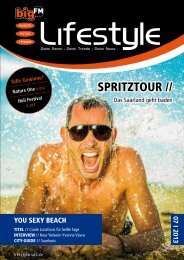EXTREME SPORTS LEARN TO RIDE
EXTREME SPORTS LEARN TO RIDE
EXTREME SPORTS LEARN TO RIDE
Create successful ePaper yourself
Turn your PDF publications into a flip-book with our unique Google optimized e-Paper software.
<strong>EXTREME</strong> <strong>SPORTS</strong><br />
BMX<br />
SKATE SKILLS<br />
FREE SKIING<br />
<strong>LEARN</strong><br />
<strong>TO</strong> <strong>RIDE</strong><br />
MAY 2013 | Nº 53 | 3 $<br />
IN SPAIN: ONLY OUTDOOR &<br />
<strong>EXTREME</strong> <strong>SPORTS</strong> MAGAZINE<br />
KING OF THE HILL<br />
Longrider<br />
Joel Fenoll<br />
INSIDE:<br />
BMX<br />
SKATE<br />
WIND-SURF<br />
DAKAR<br />
LONG<br />
PARKOUR<br />
&<br />
MORE<br />
CHECK<br />
IT OUT
SUMMARY<br />
In this editon of Extreme Sports, we<br />
want you to see a diferent way of vision<br />
of this variety of Sports with a special<br />
risk, and many adrenaline.<br />
Well, this week, we want show you<br />
Xtreme Sports which we are very sure it<br />
will like you so much. In this editon, you<br />
will be read about sports like Skate, Long-<br />
Board,MuaiThay,Surfing,WindSurf,Apnea,<br />
WingSuit,SnowBoard,BMX RED BULL,<br />
Puentng, Rally Dakar, Parkour and Raftng.
index<br />
Skate (Konrad)______________________Pag 1<br />
Long (Konrad)_______________________Pag 2<br />
Muay Thai (Konrad)__________________Pag3/4<br />
Surf (Konrad)________________________Pag 5/6<br />
Windsurf (Konrad)____________________Pag 7/8<br />
Apnea (Dani)________________________Pag 9/10<br />
Wingsuit (Dani)______________________Pag 11/12<br />
Snowboard (Dani)____________________Pag 13/14<br />
Bmx (Dani)__________________________Pag 15<br />
Red Bull Rampage (Dani)______________Pag 16<br />
Puenting (Guille)_____________________Pag 17/18<br />
Dakar (Guille)_______________________Pag 19/20<br />
Parkour (Guille)______________________Pag 21/22<br />
Rafing (Guille)_______________________Pag 23/24
Skateboarding was first started in<br />
the 1950s, when all across Califor-<br />
nia surfers got the idea of trying<br />
to surf the streets. No one really<br />
knows who made the first board -<br />
- instead, it seems that several<br />
people came up with similar ideas<br />
at the same time. Several people<br />
have claimed to have invented<br />
the skateboard first, but nothing<br />
can be proved, and skateboarding<br />
remains a strange spontaneous<br />
creation.<br />
SKATE<br />
These first skateboarders started<br />
with wooden boxes or boards<br />
with roller skate wheels slapped<br />
on the bottom. Like you might<br />
imagine, a lot of people got hurt<br />
in skateboarding's early years! It<br />
was a sport just being born and<br />
discovered, so anything went. The<br />
boxes turned into planks, and<br />
eventually companies were pro-<br />
ducing decks of pressed layers of<br />
wood -- similar to the skateboard<br />
decks of today. During this time,<br />
1<br />
skateboarding was seen as some-<br />
thing to do for fun after surfing.<br />
In 1963, skateboarding was at a<br />
peak of popularity, and compa-<br />
nies like Jack's, Hobie and Ma-<br />
kaha started holding<br />
skateboarding competitions. At<br />
this time, skateboarding was<br />
mostly either downhill slalom or<br />
freestyle.<br />
With the evolution of skateparks<br />
and ramp skating, the skateboard<br />
began to change. Early skate<br />
tricks had consisted mainly of<br />
two-dimensional freestyle mano-<br />
euvres like riding on only two<br />
wheels ("wheelie" or "manual"),<br />
spinning only on the back wheels<br />
(a "pivot"), high jumping over a<br />
bar and landing on the board<br />
again, also known as a "hippie<br />
jump", long jumping from one<br />
board to another, (often over<br />
small barrels or fearless teena-<br />
gers), or slalom. Another popular<br />
trick was the Bertlemann slide,<br />
named after Larry Bertelemann's<br />
surfing manoeuvres.
LONG BOARD<br />
Longboarding is the art/sport/hobby of riding<br />
a long skateboard, from 24" to 80".<br />
Longboarding has its roots in surfing, which<br />
is why many longboards resemble surf boards.<br />
Skateboarding in general evolved from<br />
surfing in the 70s. Much of the success and<br />
popularity of skateboarding is due to the<br />
west coast, where skaters would skate in<br />
empty pools. This style of skating still lives on<br />
today, but in relative obscurity. Longboarding<br />
started to become popular when these pool<br />
skaters started to age. Utilizing these longer<br />
skateboards let anyone, no matter their age<br />
or skill level, enjoy skateboarding.<br />
2
Disciplina surgida en Tailandia, la<br />
cual se desarrolló ya que ésta se<br />
hallaba constantemente en conflicto<br />
bélico con reinos vecinos<br />
como Birmania y Camboya. Por<br />
esto, la ciudad se vio obligada a<br />
que sus soldados pudieran manejar<br />
con destreza las lanzas, espadas,<br />
y la utilización del cuerpo<br />
como un arma en situaciones de<br />
combate a distancia corta. Técnicas<br />
como las patadas, golpes con<br />
el puño, rodillas, espinillas, codos<br />
y ciertas maneras de derribar al<br />
adversario, fueron desarrolladas<br />
en ese entonces. Durante este pe-<br />
MUAY-THAI<br />
riodo el muay thai era considerado<br />
como un arte esencial, y<br />
parte del currículum real para<br />
poder aspirar al trono.<br />
Durante los siglos siguientes, el<br />
arte continuó evolucionando. No<br />
fue hasta el reinado del rey Narai<br />
(1604-1690), caracterizado por<br />
ser una época de paz, cuando se<br />
convirtió en deporte profesional.<br />
Las peleas se efectuaban en un<br />
espacio delimitado, consistente<br />
en una cuerda sobre el piso formando<br />
un cuadro para indicar el<br />
área de combate. Las reglas eran<br />
simples: pelear hasta que uno<br />
3<br />
quedara de pie, o que uno de los<br />
dos se rindiera. No había limitaciones<br />
en cuanto a peso, estatura<br />
o edad, las aldeas competían unas<br />
contra otras y se efectuaban<br />
apuestas.<br />
WAI KRU<br />
Debe empezar el combate con<br />
un ritual. Este ritual consta de varios<br />
pasos o en su mayoría de varios<br />
rituales, los cuales sirven para<br />
ahuyentar a los supuestos malos<br />
espíritus para que el combatiente<br />
tenga una buena actuación y<br />
sobre todo, mantenga una conexión<br />
con los supuestos maestros.<br />
Estos supuestos maestros se<br />
dicen que existieron en la antigüedad<br />
y se deben contactar en la<br />
actualidad para no salir del cuadrilátero<br />
muerto y conservar la<br />
vida. El ritual previo al combate<br />
se llama wai kru.
MUAY-<br />
THAI<br />
4Whi?
SURF<br />
5<br />
Surfing is a surface water sport in which the<br />
wave rider, referred to as a "surfer", rides on<br />
the forward face of a wave, which is most<br />
often carrying the surfer towards shore.<br />
Waves suitable for surfing are primarily<br />
found in the ocean, but can also be found in<br />
lakes or in rivers in the form of a standing<br />
wave or tdal bore. However, modern-day<br />
surfing can also be done in man-made sources<br />
such as wave pools and boat wakes.The<br />
term "surfing" refers to the act of riding a<br />
wave and not the form (with or without a<br />
board) in which the wave is ridden. For instance,<br />
the natve peoples of the Pacific surfed<br />
waves on alaia, paipo, and other such<br />
crafts on their belly, knees, and feet. Not to<br />
menton, Bodysurfing, the act of surfing a<br />
wave without a board, is considered by<br />
some to be the purest form of surfing. That<br />
much said, the more modern day definiton<br />
of surfing tends to refer to when a surfer<br />
rides a wave standing up on a surfboard,<br />
which is referred to as stand-up surfing or<br />
paddleboarding. Although, another prominent<br />
form of surfing in the ocean today includes<br />
bodyboarding, which refers to when<br />
a surfer rides a wave either on the belly,<br />
dropknee, or stand-up on a bodyboard.
SURF<br />
6
WIND<br />
SURF<br />
Windsurfing is a surface water sport Some credit S. Newman Darby with Windsurfing can be said to strad-<br />
that combines elements of surfing the origination of windsurfing by dle both the laid-back culture of<br />
and sailing. It consists of a board 1965 on the Susquehanna River, surf sports and the more rules-<br />
usually 2 to 3 metres long, with a Pennsylvania, USA when he invenbased environment of sailing. Al-<br />
volume of about 60 to 250 liters, poted the "sailboard", which, incidenthough it might be considered a<br />
wered by wind on a sail. The rig is tally, he did not patent.In 1964, minimalistic version of a sailboat,<br />
connected to the board by a free-ro- Darby began selling his sailboards. A a windsurfer offers experiences<br />
tating universal joint and consists of promotional article by Darby was that are outside the scope of any<br />
a mast, 2-sided boom and sail. The published in the August 1965 edi- other sailing craf design. Wind-<br />
sail area generally ranges from 2.5 tion of Popular Science magazine. surfers can perform jumps, inver-<br />
m2 to 12 m2 depending on the con- While Darby's "sailboard" incorpoted loops, spinning maneuvers,<br />
ditions, the skill of the sailor and the rated a pivoting rig, it was "square and other "freestyle" moves that<br />
type of windsurfing being underta- rigged" and suffered all the associa- cannot be matched by any sailken.ted<br />
limitations.<br />
boat. Windsurfers were the first<br />
to ride the world's largest waves,<br />
such as Jaws on the island of<br />
Maui, and, with very few exceptions,<br />
it was not until the advent<br />
of tow-in surfing that waves of<br />
that size became accessible to<br />
surfers on more traditional surfboards.<br />
Extreme waves aside,<br />
many expert windsurfers will ride<br />
the same waves as wavesurfers<br />
do (wind permitting) and are<br />
themselves usually very accomplished<br />
without a rig on a conventional<br />
surfoard.<br />
7
At one time referred to as "surfing's ginger<br />
haired cousin" by the sport's legendary<br />
champion, Robby Naish,[7] windsurfing has<br />
long struggled to present a coherent image of<br />
the sport to outsiders. As a result of attempts<br />
to claim the word "windsurfer" as a trademark,<br />
participants have been encouraged to<br />
use different names to describe the sport, including<br />
"sailboarding" and "boardsailing".<br />
The term "windsurfing" has persisted as the<br />
accepted name for the sport, and the word<br />
"windsurfer" persists for both participants<br />
and equipment.<br />
Windsurfing is predominately undertaken on<br />
a non-competitive basis. Organised competition<br />
does take place at all levels across the<br />
world and typical formats for competitive<br />
windsurfing include Formula Windsurfing,<br />
speed sailing, slalom, course racing, wave sailing,<br />
superX, and freestyle. These events are<br />
exciting to watch as sailors push the limits<br />
both physically and creatively with moves<br />
that look as impossible as thinking them up<br />
in the first place.<br />
8<br />
Windsurfing, as a sport and recreational<br />
activity, did not emerge until the latter<br />
half of the 20th century. But before this,<br />
there have been sailing boats of various<br />
designs that have used wind as the driving<br />
force for millennia, and Polynesians have<br />
been riding waves for many of them, undertaking<br />
day trips over oceans standing<br />
upright on a solid board with a vertical<br />
sail.<br />
In 1948, 20-year old Newman Darby was<br />
the first to conceive the idea of using a<br />
handheld sail and rig mounted on a universal<br />
joint so that he could control his<br />
small catamaran—the first rudderless sailboard<br />
ever built that allowed a person to<br />
steer by shifing his or her weight in<br />
ordzto tilt the sail fore and af. Darby did<br />
not file a patent for the sailboard. However,<br />
he is widely recognized as its inventor<br />
as well as the first to conceive, design,<br />
and build a sailboard with a universalzjoint.<br />
In his own words, Darby experimented<br />
throughout much of the 1950s and<br />
1960s and it wasn't until 1963.Windsurfing,<br />
as a sport and recreational activity,<br />
did not emerge until the latter half of the<br />
20th century. But before this, there have
Freediving (or free-diving) is a form of underwater<br />
diving that relies on a diver's ability<br />
to hold his or her breath until<br />
resurfacing rather than on the use of a breathing<br />
apparatus such as scuba gear. Examples<br />
include breath-hold spear fishing,<br />
freedive photography, recreational breathhold<br />
diving, apnea competitions, and to<br />
some degree, snorkeling. The activity that<br />
garners the most public attention is the extreme<br />
sport of competitive apnea in which<br />
competitors attempt to attain great depths,<br />
times, or distances on a single breath.<br />
APNEA<br />
10<br />
Competitive freediving is currently governed<br />
by two world associations: AIDA International<br />
(International Association for Development<br />
of Apnea) and CMAS (World<br />
Underwater Federation). Most types of<br />
competitive freediving have in common that<br />
it is an individual sport based on the best individual<br />
achievement. An exception to this<br />
rule is the bi-annual World Championship<br />
for Teams, held by AIDA, where the combined<br />
score of the team members makes up<br />
the team's total points. There are currently<br />
nine disciplines used by official governing<br />
bodies and a dozen disciplines that are only<br />
practiced locally. In this article, the recognized<br />
disciplines of AIDA and CMAS will be<br />
described. All disciplines can be done by<br />
both men and women and, while done outdoors,<br />
no differences in the environment<br />
between records are recognized any longer.<br />
The disciplines of AIDA can be done both in<br />
competition and as a record attempt, with<br />
the exception of Variable Weight and No limits,<br />
which are both done solely as record<br />
attempts.
APNEA APNEA<br />
9
Another variation on which studies are<br />
being focused is the so-called wingpack,<br />
which consists of a strap-on rigid wing in<br />
carbon fibre.[8] It is a mix between a hangglider<br />
and a wingsuit. The wingpack can<br />
reach a glide ratio of 6 and permits transportation<br />
of oxygen bottles and other material.<br />
On 31 July 2003, the Austrian Felix Baumgartner,<br />
jumping from 29,360 ft (9 km), successfully<br />
crossed the English Channel in 14<br />
minutes using a wingpack, having covered<br />
over 35 km (21.8 mi).<br />
WING-<br />
SUIT<br />
11<br />
Wingsuit flying is the sport of flying the<br />
human body through the air using a special<br />
jumpsuit, called a wingsuit, which adds surface<br />
area to the human body to enable a<br />
significant increase in lift. Modern wingsuits,<br />
first developed in the late 1990s, create the<br />
surface area with fabric between the legs<br />
and under the arms. Wingsuits are sometimes<br />
referred to as a birdman suit (after the<br />
makers of the first commercially available<br />
wingsuit), flying squirrel suit (due to their<br />
resemblance to the animal. Squirrel is now<br />
the name of a commercial wingsuit manufacturer),<br />
or bat suit (due to their vague resemblance<br />
to the animal or perhaps the<br />
superhero).A wingsuit flight normally ends<br />
with a parachute opening. So a wingsuit can<br />
safely be flown from any point that provides<br />
sufficient altitude for flight and parachute<br />
deployment (normally a skydiving drop aircraft<br />
or BASE jump exit point).<br />
The wingsuit flier wears parachute equipment<br />
designed for skydiving or BASE jumping.
WING<br />
SUIT<br />
12
SnowBoarding<br />
Snowboarding is a winter sport that involves<br />
descending a slope that is covered with<br />
snow while standing on a board attached to<br />
a rider's feet, using a special boot set onto a<br />
mounted binding. The development of<br />
snowboarding was inspired by skateboarding,<br />
sledding, surfing and skiing. It was developed<br />
in the United States in the 1960s<br />
and became a Winter Olympic Sport in<br />
1998. In 2002 competitive snowboarders<br />
formed the World Snowboard Tour.<br />
Snowboarding has been around since the<br />
1920s, when boys and men would tie<br />
plywood or wooden planks from barrels to<br />
their feet using clotheslines and horse reins<br />
in order to steer themselves down hills. Modern<br />
snowboarding began in 1965 when<br />
Sherman Poppen, an engineer in Muskegon,<br />
Michigan, invented a toy for his daughter by<br />
fastening two skis together and attaching a<br />
rope to one end so she would have some<br />
control as she stood on the board and glided<br />
downhill.<br />
13
Shaun White<br />
Shaun Roger White is an american<br />
professional skateboarder<br />
and snowboarder.He is a<br />
two tme Olympic gold medalist.In<br />
the last eleven years he<br />
has won 28 gold medals, 6 silver<br />
medals and 3 bronce medals.<br />
Early Life<br />
White was born in San Diego, California.<br />
His ancestry includes Irish<br />
and Italian. He was born with a Tetralogy<br />
of Fallot, a congenital heart<br />
defect for which he endured two<br />
open-heart operatons before the<br />
age of one. He stands 5'8" (1.73 m)<br />
tall. White spent his formatve years<br />
riding Okemo Mountain and Bear<br />
Mountain, small ski resorts found in<br />
Ludlow, Vermont, and the San Ber-<br />
nardino Mountains of Southern California.<br />
14<br />
Snowboarding<br />
career<br />
White has partcipated in two<br />
Winter Olympics in his career. At<br />
both the 2006 and 2010 Winter<br />
Olympics, White won gold in the<br />
snowboard halfpipe event. White<br />
has also partcipated in the Winter<br />
X Games, where he has won a<br />
medal every year since 2002. Including<br />
all winter X Games compettons<br />
through 2009, his medal<br />
count stands at 15 (10 gold, 3 sil-<br />
ver, 2 bronze), among which is<br />
the first quadruple win streak by<br />
a male athlete in one discipline,<br />
the .
BMX<br />
Bicycle motocross or BMX is the sport of racing bicycles in motocross The 1972 motorcycle racing do-<br />
style on tracks which use an inline start and have obstacles, and also recumentary On Any Sunday is gefers<br />
to the bicycle itself, which is designed for dirt and motocross nerally credited with inspiring the<br />
cycling.BMX began in the early 1970s when children began racing their movement nationally in the Uni-<br />
bicycles on dirt tracks in southern California, inspired by the motocross ted States; its opening scene<br />
stars of the time. The size and availability of the Schwinn Sting-Ray and shows kids riding their Sting-Rays<br />
other wheelie bikes made them the natural bike of choice for these off-road. By the middle of that de-<br />
races, since they were easily customized for better handling and perforcade the sport achieved critical<br />
mance. BMX racing was a phenomenon by the mid-1970s. Children were mass, and manufacturers began<br />
racing standard road bikes off-road, around purpose-built tracks in Cali- creating bicycles designed espefornia.cially<br />
for the sport.<br />
George E. Esser founded the National<br />
Bicycle League as a nonprofit<br />
bicycle motocross<br />
sanctioning organization in 1974.<br />
Before they set up the NBL, Esser<br />
and his wife, Mary, sanctioned<br />
motorcycle races with the American<br />
Motocross Association<br />
(AMA). Their two sons, Greg and<br />
Brian, raced motorcycles, but also<br />
enjoyed riding and racing BMX<br />
with their friends. It was their<br />
sons’ interest, and the lack of<br />
BMX organizations in the East,<br />
which prompted Esser to start the<br />
NBL in Florida.<br />
15
Red Bull<br />
Rampage<br />
16<br />
The Red Bull Rampage is an invite-only freeride<br />
mountain bike competton held near<br />
Zion Natonal Park in Virgin, Utah, USA, just<br />
to the north of Gooseberry Mesa. Previously<br />
it was held off the Kolob Terrace Road, on<br />
the western boundary of Zion Natonal<br />
Park.[1] The competton was held from<br />
2001–2004 and then canceled due to the increasing<br />
risk compettors were taking. The<br />
Rampage however was re-introduced for<br />
the 2008 season. In 2010, the event was<br />
held October 1–3.<br />
The event is similar to freestyle skiing and<br />
snowboarding, where compettors are judged<br />
on their choice of lines down the<br />
course, their technical ability and the complexity<br />
of tricks. For the 2008 event wooden<br />
features have been introduced to what has<br />
previously been a 'Natural' only course.
Bungee jumping is an activity that involves<br />
jumping from a tall structure while connected<br />
to a large elastic cord. The tall structure<br />
is usually a fixed object, such as a building,<br />
bridge or crane; but it is also possible to<br />
jump from a movable object, such as a hotair-balloon<br />
or helicopter, that has the ability<br />
to hover. When the person jumps, the cord<br />
stretches and the jumper flies upwards<br />
again as the cord recoils, and continues to<br />
oscillate up and down until all the energy is<br />
dissipated.<br />
The highest jump<br />
In August 2005, AJ Hackett added a<br />
SkyJump to the Macau Tower, making<br />
it the world's highest jump at 233 metres<br />
(764 f).The SkyJump did not qualify<br />
as the world's highest bungee as it<br />
is not strictly speaking a bungee<br />
jump, but instead what is referred to<br />
as a 'Decelerator-Descent' jump, using<br />
a steel cable and decelerator system,<br />
rather than an elastic rope.On 17 December<br />
2006, the Macau Tower started<br />
operating a proper bungee jump,<br />
which became the "Highest Commercial<br />
Bungee Jump In The World" according<br />
to the Guinness Book of<br />
Records.
PUENTING
DAKAR<br />
The Dakar Rally is an annual Dakar Series rally raid<br />
type of off-road race, organised by the Amaury Sport<br />
Organisaton. Most events since the incepton in 1978<br />
were from Paris, France, to Dakar, Senegal, but due to<br />
security threats in Mauritania, which led to the cancellaton<br />
of the 2008 rally, the 2009 Dakar Rally was run<br />
in South America.It was the first tme the race took<br />
place outside of Europe and Africa.[1] It has stayed in<br />
South America from 2009 to the present (2013).[2][3]<br />
The race is open to amateur and professional entries.<br />
Amateurs typically make up about eighty percent of<br />
the partcipants.<br />
Despite its 'rally' name, it is an off-road endurance<br />
race, properly called a rally raid rather than a conventonal<br />
rally. The terrain that the compettors traverse<br />
is much tougher and the vehicles used are true offroad<br />
vehicles rather than the modified on-road vehicles<br />
used in rallies. Most of the compettve special<br />
sectons are off-road, crossing dunes, mud, camel<br />
grass, rocks and erg among others. The distances of<br />
each stage covered vary from short distances up to<br />
800–900 kilometres (500–560 mi) per day.The three<br />
major compettve groups in the Dakar are the motorcycle<br />
(moto) class (including quadbikes as one of<br />
the sub-classes), the car class, (which ranges from<br />
buggies to small SUVs) and the truck class.<br />
Many vehicle manufacturers exploit the harsh environment<br />
the rally offers as a testng ground and<br />
consequently to demonstrate the durability of their<br />
vehicles, although most vehicles are heavily modified<br />
or purpose built.Over 190 different countries<br />
take the internatonal feed of the event with a<br />
roundup of every day being made into a 26-minute<br />
programme. This has been commentated on by<br />
Toby Moody for ten years, but Ben Constanduros<br />
speaks on the 2011 editon.A television documentary<br />
Race to Dakar described the experiences of a<br />
team including the actor Charley Boorman in preparaton<br />
for and entry into the 2006 Dakar Rally.
In 1982, Mark Thatcher, son of the then British Prime Minister Margaret Thatcher, along with his French codriver<br />
Anne-Charlotte Verney and their mechanic, disappeared for six days. On January 9, the trio became<br />
separated from a convoy of vehicles afer they stopped to make repairs to a faulty steering arm. They were<br />
declared missing on January 12; afer a large-scale search, a Lockheed L100 search plane from the Algerian<br />
military spotted their white Peugeot 504 some 50 km (30 mi) off course. Thatcher, Verney and the mechanic<br />
were all unharmed.<br />
The organiser of the rally, Thierry Sabine, was killed when his Ecureuil helicopter crashed at 07:30 p.m. on<br />
Tuesday 14 January 1986, into a dune at Mali during a sudden sand-storm. Also killed onboard was the singer-songwriter<br />
Daniel Balavoine, helicopter pilot François-Xavier Bagnoud, journalist Nathalie Odent and<br />
Jean-Paul Lefur who was a radiophonic engineer for RTL.Six people were killed during the 1988 race, three<br />
participants and three local residents. In one incident, Baye Sibi, a 10-year-old Malian girl, was killed by a<br />
racer while she crossed a road. A film crew's vehicle killed a mother and daughter in Mauritania on the last<br />
day of the race.
PARKOUR<br />
Parkour is not widely practiced in dedicated public<br />
facilities. Although efforts are being made to create<br />
places for it, some traceurs do not like the idea as<br />
it is contradictory to Parkour's value of<br />
freedom.Traceurs practice Parkour in both rural<br />
and urban areas such as gyms, parks, playgrounds,<br />
offices, and abandoned structures.<br />
Parkou is a holistc training discipline using<br />
movement that developed out of military<br />
obstacle course training. Practtoners aim<br />
to move quickly and efficiently through<br />
their environment using only their bodies<br />
and their surroundings to propel themselves,<br />
negotatng obstacles in between.<br />
They try to maintain as much momentum<br />
as possible without being unsafe. Parkour<br />
can include running, climbing, swinging,<br />
vaultng, jumping, rolling, quadrupedal<br />
movement and more, if they are the most<br />
suitable movements for the situaton. Parkour<br />
is non-compettve. It may be performed<br />
on an obstacle course, but is usually<br />
practced in a creatve (and sometmes<br />
playful) reinterpretaton or subversion of<br />
urban spaces.Parkour involves 'seeing'<br />
one's environment in a new way, and imagining<br />
the potentalites for movement<br />
around it.Developed by Raymond Belle,<br />
David Belle, Sébasten Foucan and others<br />
in the late 1980s,Parkour became popular<br />
in the late 1990s and 2000s through films,<br />
documentaries and advertsements featuring<br />
these practtoners and others.
There is no equipment required, although practtoners<br />
normally train wearing light casual clothing like<br />
comfortable running shoes, ones that are generally<br />
light, with good grip and flexibility are<br />
encouraged.Various sport-shoes manufacturers,<br />
such as Nike, with its "Free run" shoes, have developed<br />
shoes specifically for Parkour and Freerunning;<br />
and many other companies around the world have<br />
started offering Parkour-specific products.<br />
There have been a few documentaries about Parkour<br />
on major television networks. Jump London is<br />
a 2003 documentary which explains some of the<br />
background to Parkour and culminated with Sébasten<br />
Foucan, Johann Vigroux, and Jérôme Ben<br />
Aoues demonstratng their Parkour skills. Jump<br />
London was followed by Jump Britain in 2005,<br />
which featured Foucan and Ben Aoeus.
RAFTING<br />
Rafts come in a few different forms. In<br />
Europe and Australasia, the most common<br />
is the symmetrical raft steered<br />
with a paddle at the stern. Other types<br />
are the asymmetrical, rudder-controlled<br />
raft and the symmetrical raft with<br />
central helm (oars) or Stern Mounts<br />
with the oar frame located at the rear<br />
of the raft. Rafts are usually propelled<br />
with ordinary paddles and or oars and<br />
typically hold 4 to 12 persons. In Russia,<br />
rafts are often hand made and are<br />
often a catamaran style with two inflatable<br />
tubes attached to a frame. Pairs of<br />
paddlers navigate on these rafts. Catamaran<br />
style rafts have become popular<br />
in the western United States as well,<br />
but are typically rowed instead of paddled.Below<br />
are the six grades of difficulty<br />
in white water rafting. They range<br />
from simple to very dangerous and potential<br />
death or serious injuries.<br />
Rafting or white water rafting is<br />
the challenging recreational outdoor<br />
activity of using an inflatable<br />
raft to navigate a river or other<br />
bodies of water. This is usually<br />
done on white water or different<br />
degrees of rough water, in order<br />
to thrill and excite the raft passengers.<br />
The development of this activity<br />
as a leisure sport has<br />
become popular since the mid-<br />
1970s. It is considered an extreme<br />
sport, as it can be dangerous.The<br />
modern raft is an inflatable boat,<br />
consisting of very durable, multilayeredsmall<br />
as 1.5 metres (4.9 ft)<br />
long and weigh as little as 4<br />
pounds (1.8 kg).
White water rafting can be a dangerous sport, especially if basic safety precautions are not observed. Both<br />
commercial and private trips have seen their share of injuries and fatalities, though private travel has typically<br />
been associated with greater risk.[citation needed] Depending on the area, safety regulations covering<br />
raft operators may exist in legislation. These range from certification of outfitters, rafts, and raft leaders, to<br />
more stringent regulations about equipment and procedures. It is generally advisable to discuss safety measures<br />
with a rafting operator before signing on for a trip. The equipment used and the qualifications of the<br />
company and raft guides are essential information to be considered.Like most outdoor sports, rafting in general<br />
has become safer over the years. Expertise in the sport has increased, and equipment has become<br />
more specialized and increased in quality. As a result the difficulty rating of most river runs has changed. A<br />
classic example would be the Colorado River in the Grand Canyon or Jalcomulco River in Mexico, which has<br />
swallowed whole expeditions in the past, leaving only fragments of boats. In contrast, it is now run safely<br />
by commercial outfitters hundreds of times each year with relatively untrained passengers.[1]Risks in white<br />
water rafting stem from both environmental dangers and from improper behavior. Certain features on rivers<br />
are inherently unsafe and have remained consistently so despite the passage of time. These would include<br />
"keeper hydraulics", "strainers" (e.g. fallen trees), dams (especially low-head dams, which tend to<br />
produce river-wide keeper hydraulics), undercut rocks, and of course dangerously high waterfalls. Rafting<br />
with experienced guides is the safest way to avoid such features. Even in safe areas, however, moving water<br />
can always present risks—such as when a swimmer attempts to stand up on a rocky riverbed in strong current,<br />
risking foot entrapment.
ENJOY LIFE...<br />
Son Caliu<br />
C/Castellon 40<br />
Tel:971 69 96 96<br />
Fax 971 69 95 15<br />
Hour:8:00 - 13:00<br />
The XGames is the place<br />
to be if u are a fan of extreme<br />
sports.The best of<br />
the best come here to<br />
show their skills.<br />
Come check it out at:<br />
Xgames.com<br />
Speed eating is a sport<br />
in wich participants<br />
consume large quantites<br />
of food in short in a<br />
short time period.<br />
www.KDGmagazine.com
















